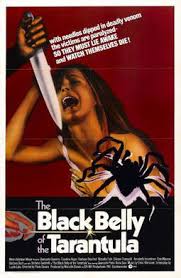
Paolo Zani (Silvano Tranquilli) accuses his estranged wife Maria (Barbara Bouchet) of having an affair. In a rage he leaves with the incriminating evidence, a photograph. That night a man wearing a trench coat and latex gloves enters her house. Using a long poison dipped needle, he injects her with the venom of the Tarantula Hawk Wasp. The poison causes the body to become paralyzed. With Maria unable to move, but still aware of everything around her, the killer slices her open with a knife. Maria is watching herself die.
Inspector Tellini (Giancarlo Giannini) is assigned to the case and Paolo, the separated husband, is suspect number one. Paolo hires a private detective that goes by the name of La Catapulta, the catapult (Ettore Mattia), to find the man in the picture with his wife.
Not long after that a saleswoman, Mirta Ricci (Annabella Incontrera), is murdered in her shop. Again the victim is stabbed in the neck with a poison laced needle. She is then stabbed with a large knife while she is still alive and unable to move. The police find cocaine in the shop. Tellini visits an entomologist (Daniele Dublino) who explains to him the role of the wasp and its venom. The entomologist has a tarantula in a small plastic case. In with the spider is cocaine.
While following the drug connection Tellini also finds a blackmail scheme. Several of the victims have been contacted via the mail by the blackmailer. Naked pictures of the women with a man are sent with payment instructions. Paolo is also after the blackmailer. Tellini identifies the man in the picture with Paolo’s wife as Mario (Giancarlo Prete). When Tellini tries to corner Mario, the blackmailer is run over by his own car.
Things start to get personal when Tellini is taped having sex with his wife Anna (Stefania Sandrelli) by the killer. The tape is found at Mario’s apartment. With more young women getting murdered Tellini is worried that Anna may be on the killer’s list.
“The Black Belly of the Tarantula” AKA “La Tarantola dal Ventre Nero” was released in 1971 and was directed by Paolo Cavara. It is an Italian Giallo style movie. The film fell into obscurity among all the other Giallo style films but has since gained a small fan base.
Giallo is Italian for yellow. The term is taken from a type of cheap paperback murder mystery that was popular in Italy at one time. These mysteries usually had yellow covers. Quite often these films contain slasher elements, sexploitation, psychological horror or thriller elements and sometimes supernatural horror elements. Sometimes they are referred to as thriller/horror films. The mystery killer is usually revealed at the end of the film. These films were popular during the sixties and early seventies and are believed to give rise to the classic slasher movie genre. It’s basically pulp fiction with style.
Three Bond girls appeared in this film, Barbara Bouchet from “Casino Royale” 1967, Claudine Auger from “Thunderball” 1965 and Barbara Bach from “The Spy Who Loved me” 1977. This is an Italian film with lots of pretty women in it so there is a lot of nudity.
I found the film actually interesting. And extremely creepy. Giallo films have a tendency to be, shall we say artistic. That in itself is not a problem unless the artistry overtakes the film to the point where you don’t really know what is going on or where the film is going. There were a few red herrings which did sidetrack the plot a little but for the most part the film was basically solid. Exploitative, yes, but still a good example of the genre.
“The Hawk Wasp” or “Tarantula Hawk” is a member of the Hymenoptera Order. In other words ants, bees and wasps. It preys on tarantulas. They use their stinger to paralyze their prey. They drag the paralyzed spider to a brood nest and deposit one egg on the spider to use as living food for the larva that hatches. They are among the largest of the wasps. They have blue-black bodies and rust colored wings. Even though they are usually docile, the sting of the female is considered one of the most painful in the world. There are many varieties of spider wasps all over the United States. Even though they have a sinister reputation they are pollinators and help to control the infestation of other insects so they are considered beneficial.

